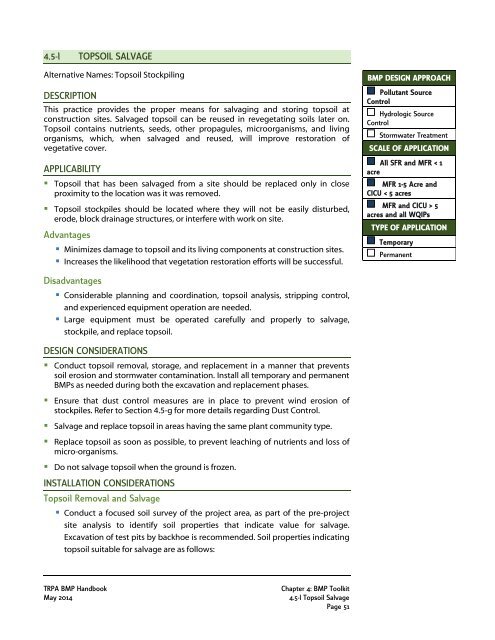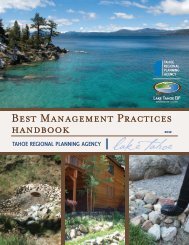4.5-l TOPSOIL SALVAGE DESCRIPTION ... - Tahoe BMP
4.5-l TOPSOIL SALVAGE DESCRIPTION ... - Tahoe BMP
4.5-l TOPSOIL SALVAGE DESCRIPTION ... - Tahoe BMP
You also want an ePaper? Increase the reach of your titles
YUMPU automatically turns print PDFs into web optimized ePapers that Google loves.
<strong>4.5</strong>-l<br />
<strong>TOPSOIL</strong> <strong>SALVAGE</strong><br />
Alternative Names: Topsoil Stockpiling<br />
<strong>DESCRIPTION</strong><br />
This practice provides the proper means for salvaging and storing topsoil at<br />
construction sites. Salvaged topsoil can be reused in revegetating soils later on.<br />
Topsoil contains nutrients, seeds, other propagules, microorganisms, and living<br />
organisms, which, when salvaged and reused, will improve restoration of<br />
vegetative cover.<br />
APPLICABILITY<br />
• Topsoil that has been salvaged from a site should be replaced only in close<br />
proximity to the location was it was removed.<br />
• Topsoil stockpiles should be located where they will not be easily disturbed,<br />
erode, block drainage structures, or interfere with work on site.<br />
Advantages<br />
• Minimizes damage to topsoil and its living components at construction sites.<br />
• Increases the likelihood that vegetation restoration efforts will be successful.<br />
<strong>BMP</strong> DESIGN APPROACH<br />
Pollutant Source<br />
Control<br />
Hydrologic Source<br />
Control<br />
Stormwater Treatment<br />
SCALE OF APPLICATION<br />
All SFR and MFR < 1<br />
acre<br />
MFR 1-5 Acre and<br />
CICU < 5 acres<br />
MFR and CICU > 5<br />
acres and all WQIPs<br />
TYPE OF APPLICATION<br />
Temporary<br />
Permanent<br />
Disadvantages<br />
• Considerable planning and coordination, topsoil analysis, stripping control,<br />
and experienced equipment operation are needed.<br />
• Large equipment must be operated carefully and properly to salvage,<br />
stockpile, and replace topsoil.<br />
DESIGN CONSIDERATIONS<br />
• Conduct topsoil removal, storage, and replacement in a manner that prevents<br />
soil erosion and stormwater contamination. Install all temporary and permanent<br />
<strong>BMP</strong>s as needed during both the excavation and replacement phases.<br />
• Ensure that dust control measures are in place to prevent wind erosion of<br />
stockpiles. Refer to Section <strong>4.5</strong>-g for more details regarding Dust Control.<br />
• Salvage and replace topsoil in areas having the same plant community type.<br />
• Replace topsoil as soon as possible, to prevent leaching of nutrients and loss of<br />
micro-organisms.<br />
• Do not salvage topsoil when the ground is frozen.<br />
INSTALLATION CONSIDERATIONS<br />
Topsoil Removal and Salvage<br />
• Conduct a focused soil survey of the project area, as part of the pre-project<br />
site analysis to identify soil properties that indicate value for salvage.<br />
Excavation of test pits by backhoe is recommended. Soil properties indicating<br />
topsoil suitable for salvage are as follows:<br />
TRPA <strong>BMP</strong> Handbook<br />
May 2014<br />
Chapter 4: <strong>BMP</strong> Toolkit<br />
<strong>4.5</strong>-l Topsoil Salvage<br />
Page 51
• Location: Depth of topsoil is usually associated with its position in the<br />
landscape. Deeper topsoils can be generally expected in depositional<br />
settings, such as draws and valley floors, while ridge tops generally have<br />
shallower topsoils.<br />
• Color: Brownish earth tones indicate the presence of organic matter in<br />
mineral soil. The upper portion of soil having these colors should be<br />
considered for salvage. The top of the subsoil, indicated by a distinct color<br />
and texture change, indicates the appropriate depth limit of salvage.<br />
• Structure: Topsoil tends to have a more developed structure (blocky, subangular<br />
blocky, or granular) than the more-massive subsoil.<br />
• Texture: Topsoils that contain too much sand or clay may need to be<br />
excluded, because they may be too erodible, droughty, or poorly-drained,<br />
characteristics not suited to revegetation with many plant types.<br />
• Root Zone: Depth of extensive rooting of plants is often a good indicator<br />
of the limits of the topsoil.<br />
• Establish topsoil salvage limits prior to salvage operations, and document the<br />
plant community type with which the topsoil is associated.<br />
• Ensure excavated topsoil is free of coarse debris (vegetation, rocks, and<br />
foreign materials).<br />
• Proceed from higher to lower topographical areas when stripping topsoil.<br />
• Remove topsoil as late as possible in the construction sequence.<br />
• After topsoil removal, establish and maintain a clear boundary delineating the<br />
area from which soil has been stripped. Apply erosion and sediment control<br />
measures to this area until construction ends and/or revegetation is<br />
successful.<br />
Topsoil Hauling and Storage<br />
• Store excavated topsoil and any excavated subsoil separately.<br />
• Store salvaged upland topsoil separately from wetland/SEZ topsoil.<br />
• Limit steepness of topsoil piles to 3:1 (run to rise).<br />
• Cover topsoil salvage piles with erosion control matting or geotextiles, not<br />
plastic.<br />
• If topsoil will not be used for an extended amount of time, allow a cover of<br />
volunteer vegetation to establish. This plant cover enables some of the soil<br />
components to remain healthy and alive.<br />
Topsoil Replacement<br />
• When feasible, replace topsoil immediately after grading operations end.<br />
• Till, disc, harrow, or scarify subsoil to a depth of 6 inches prior to placement of<br />
topsoil, in order to loosen compacted layers and promote infiltration.<br />
• Spread topsoil uniformly over the designated areas to the specified depth.<br />
• Limit foot access and equipment traffic over top-soiled areas, to prevent<br />
compaction of replaced soil.<br />
Chapter 4: <strong>BMP</strong> Toolkit<br />
TRPA <strong>BMP</strong> Handbook<br />
<strong>4.5</strong>-l Topsoil Salvage May 2014<br />
Page 52
INSPECTION AND MAINTENANCE<br />
• Verify that only topsoil is being removed during topsoil salvage operations.<br />
• Verify that all applicable <strong>BMP</strong>s are in place. Repair/replace perimeter controls<br />
and stockpile covers as needed to keep them functioning properly.<br />
• Inspect areas of newly-applied topsoil to gauge success of vegetation<br />
establishment. Re-apply topsoil to areas of erosion or settlement to achieve<br />
successful revegetation.<br />
TRPA <strong>BMP</strong> Handbook<br />
May 2014<br />
Chapter 4: <strong>BMP</strong> Toolkit<br />
<strong>4.5</strong>-l Topsoil Salvage<br />
Page 53
Chapter 4: <strong>BMP</strong> Toolkit<br />
TRPA <strong>BMP</strong> Handbook<br />
<strong>4.5</strong>-l Topsoil Salvage May 2014<br />
Page 54

















